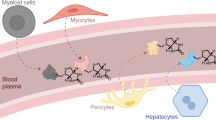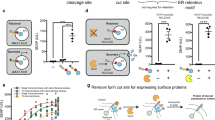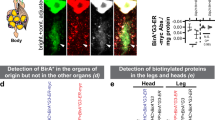Abstract
The maintenance of organ homeostasis and the control of an appropriate response to environmental alterations require the intimate coordination of cellular functions and tissue organization. An important component of this coordination could be provided by proteins that can have distinct but linked functions on both sides of the plasma membrane. We present a model that proposes that unconventional secretion provides a mechanism through which single proteins can integrate complex tissue functions.
This is a preview of subscription content, access via your institution
Access options
Subscribe to this journal
Receive 12 print issues and online access
$189.00 per year
only $15.75 per issue
Buy this article
- Purchase on Springer Link
- Instant access to full article PDF
Prices may be subject to local taxes which are calculated during checkout


Similar content being viewed by others
References
Hirai, Y., Takebe, K., Takashina, M., Kobayashi, S. & Takeichi, M. Epimorphin: a mesenchymal protein essential for epithelial morphogenesis. Cell 69, 471–481 (1992).
Radisky, D. C., Hirai, Y. & Bissell, M. J. Delivering the message: epimorphin and mammary epithelial morphogenesis. Trends Cell Biol. 13, 426–434 (2003).
Hirai, Y. et al. Epimorphin mediates mammary luminal morphogenesis through control of C/EBPβ. J. Cell Biol. 153, 785–794 (2001).
Bascom, J. L., Fata, J. E., Hirai, Y., Sternlicht, M. D. & Bissell, M. J. Epimorphin overexpression in the mouse mammary gland promotes alveolar hyperplasia and mammary adenocarcinoma. Cancer Res. 65, 8617–8621 (2005).
Hirai, Y., Bissell, M. J. & Radisky, D. C. Extracellular localization of epimorphin/syntaxin-2. Blood 110, 3082 (2007).
Ungar, D. & Hughson, F. M. SNARE protein structure and function. Annu. Rev. Cell Dev. Biol. 19, 493–517 (2003).
Bennett, M. K. et al. The syntaxin family of vesicular transport receptors. Cell 74, 863–873 (1993).
Chen, D., Lemons, P. P., Schraw, T. & Whiteheart, S. W. Molecular mechanisms of platelet exocytosis: role of SNAP-23 and syntaxin 2 and 4 in lysosome release. Blood 96, 1782–1788 (2000).
Abonyo, B. O. et al. Syntaxin 2 and SNAP-23 are required for regulated surfactant secretion. Biochemistry 43, 3499–3506 (2004).
Low, S. H. et al. Syntaxin 2 and endobrevin are required for the terminal step of cytokinesis in mammalian cells. Dev. Cell 4, 753–759 (2003).
Pelham, H. R. Is epimorphin involved in vesicular transport? Cell 73, 425–426 (1993).
Hirai, Y., Nakagawa, S. & Takeichi, M. Reexamination of the properties of epimorphin and its possible roles. Cell 73, 426–427 (1993).
Huttunen, H. J. & Rauvala, H. Amphoterin as an extracellular regulator of cell motility: from discovery to disease. J. Intern. Med. 255, 351–366 (2004).
Lotze, M. T. & Tracey, K. J. High-mobility group BOX 1 protein (HMGB1): nuclear weapon in the immune arsenal. Nature Rev. Immunol. 5, 331–342 (2005).
Muller, S. et al. New EMBO members' review: the double life of HMGB1 chromatin protein: architectural factor and extracellular signal. EMBO J. 20, 4337–4340 (2001).
Wang, H. et al. HMG-1 as a late mediator of endotoxin lethality in mice. Science 285, 248–251 (1999).
Fages, C., Nolo, R., Huttunen, H. J., Eskelinen, E. & Rauvala, H. Regulation of cell migration by amphoterin. J. Cell Sci. 113, 611–620 (2000).
Gardella, S. et al. The nuclear protein HMGB1 is secreted by monocytes via a non-classical, vesicle-mediated secretory pathway. EMBO Rep. 3, 995–1001 (2002).
Agresti, A. & Bianchi, M. E. HMGB proteins and gene expression. Curr. Opin. Genet. Dev. 13, 170–178 (2003).
Thomas, J. O. & Travers, A. A. HMG1 and 2, and related 'architectural' DNA-binding proteins. Trends Biochem. Sci. 26, 167–174 (2001).
Bianchi, M. E., Beltrame, M. & Paonessa, G. Specific recognition of cruciform DNA by nuclear protein HMG1. Science 243, 1056–1059 (1989).
Stros, M., Muselikova-Polanska, E., Pospisilova, S. & Strauss, F. High-affinity binding of tumor-suppressor protein p53 and HMGB1 to hemicatenated DNA loops. Biochemistry 43, 7215–7225 (2004).
Lorand, L. & Graham, R. M. Transglutaminases: crosslinking enzymes with pleiotropic functions. Nature Rev. Mol. Cell Biol. 4, 140–156 (2003).
Boehm, J. E., Singh, U., Combs, C., Antonyak, M. A. & Cerione, R. A. Tissue transglutaminase protects against apoptosis by modifying the tumor suppressor protein p110 Rb. J. Biol. Chem. 277, 20127–20130 (2002).
Milakovic, T., Tucholski, J., McCoy, E. & Johnson, G. V. Intracellular localization and activity state of tissue transglutaminase differentially impacts cell death. J. Biol. Chem. 279, 8715–8722 (2004).
Stephens, P. et al. Crosslinking and G-protein functions of transglutaminase 2 contribute differentially to fibroblast wound healing responses. J. Cell Sci. 117, 3389–3403 (2004).
Belkin, A. M. et al. Matrix-dependent proteolysis of surface transglutaminase by membrane-type metalloproteinase regulates cancer cell adhesion and locomotion. J. Biol. Chem. 276, 18415–18422 (2001).
Aeschlimann, D. & Paulsson, M. Cross-linking of laminin–nidogen complexes by tissue transglutaminase. A novel mechanism for basement membrane stabilization. J. Biol. Chem. 266, 15308–15317 (1991).
Akimov, S. S. & Belkin, A. M. Cell-surface transglutaminase promotes fibronectin assembly via interaction with the gelatin-binding domain of fibronectin: a role in TGFβ-dependent matrix deposition. J. Cell Sci. 114, 2989–3000 (2001).
Verderio, E. A., Johnson, T. & Griffin, M. Tissue transglutaminase in normal and abnormal wound healing: review article. Amino Acids 26, 387–404 (2004).
Maxwell, C. A., McCarthy, J. & Turley, E. Cell-surface and mitotic-spindle RHAMM: moonlighting or dual oncogenic functions? J. Cell Sci. 121, 925–932 (2008).
Sharma, M. C. & Sharma, M. The role of annexin II in angiogenesis and tumor progression: a potential therapeutic target. Curr. Pharm. Des. 13, 3568–3575 (2007).
Tomas, A., Futter, C. & Moss, S. E. Annexin 11 is required for midbody formation and completion of the terminal phase of cytokinesis. J. Cell Biol. 165, 813–822 (2004).
Jacob, R. et al. Annexin II is required for apical transport in polarized epithelial cells. J. Biol. Chem. 279, 3680–3684 (2004).
Torimura, T. et al. Autocrine motility factor enhances hepatoma cell invasion across the basement membrane through activation of β1 integrins. Hepatology 34, 62–71 (2001).
Tsutsumi, S. et al. The enzymatic activity of phosphoglucose isomerase is not required for its cytokine function. FEBS Lett. 534, 49–53 (2003).
Sun, Y. J. et al. The crystal structure of a multifunctional protein: phosphoglucose isomerase/autocrine motility factor/neuroleukin. Proc. Natl Acad. Sci. USA 96, 5412–5417 (1999).
Monferran, S., Muller, C., Mourey, L., Frit, P. & Salles, B. The membrane-associated form of the DNA repair protein Ku is involved in cell adhesion to fibronectin. J. Mol. Biol. 337, 503–511 (2004).
Pierce, A. J., Hu, P., Han, M., Ellis, N. & Jasin, M. Ku DNA end-binding protein modulates homologous repair of double-strand breaks in mammalian cells. Genes Dev. 15, 3237–3242 (2001).
Hirai, Y. et al. Epimorphin functions as a key morphoregulator for mammary epithelial cells. J. Cell Biol. 140, 159–169 (1998).
Pasheva, E. et al. In vitro acetylation of HMGB-1 and -2 proteins by CBP: the role of the acidic tail. Biochemistry 43, 2935–2940 (2004).
Ueda, T., Chou, H., Kawase, T., Shirakawa, H. & Yoshida, M. Acidic C-tail of HMGB1 is required for its target binding to nucleosome linker DNA and transcription stimulation. Biochemistry 43, 9901–9908 (2004).
Huttunen, H. J., Fages, C., Kuja-Panula, J., Ridley, A. J. & Rauvala, H. Receptor for advanced glycation end products-binding COOH-terminal motif of amphoterin inhibits invasive migration and metastasis. Cancer Res. 62, 4805–4811 (2002).
Pekkari, K. et al. Truncated thioredoxin (Trx80) exerts unique mitogenic cytokine effects via a mechanism independent of thiol oxido-reductase activity. FEBS Lett. 539, 143–148 (2003).
Hirai, Y. Epimorphin as a morphogen: does a protein for intracellular vesicular targeting act as an extracellular signaling molecule? Cell Biol. Int. 25, 193–195 (2001).
Hirai, Y. et al. Non-classical export of epimorphin and its adhesion to αv-integrin in regulation of epithelial morphogenesis. J. Cell Sci. 120, 2032–2043 (2007).
Nickel, W. & Seedorf, M. Unconventional mechanisms of protein transport to the cell surface of eukaryotic cells. Annu. Rev. Cell Dev. Biol. 24, 287–308 (2008).
Prudovsky, I. et al. Secretion without Golgi. J. Cell. Biochem. 103, 1327–1343 (2008).
Scaffidi, P., Misteli, T. & Bianchi, M. E. Release of chromatin protein HMGB1 by necrotic cells triggers inflammation. Nature 418, 191–195 (2002).
Bonaldi, T. et al. Monocytic cells hyperacetylate chromatin protein HMGB1 to redirect it towards secretion. EMBO J. 22, 5551–5560 (2003).
Kondo, N. et al. Redox-sensing release of human thioredoxin from T lymphocytes with negative feedback loops. J. Immunol. 172, 442–448 (2004).
Seelenmeyer, C., Stegmayer, C. & Nickel, W. Unconventional secretion of fibroblast growth factor 2 and galectin-1 does not require shedding of plasma membrane-derived vesicles. FEBS Lett. 582, 1362–1368 (2008).
Glasner, M. E., Gerlt, J. A. & Babbitt, P. C. Evolution of enzyme superfamilies. Curr. Opin. Chem. Biol. 10, 492–497 (2006).
Redfern, O. C., Dessailly, B. & Orengo, C. A. Exploring the structure and function paradigm. Curr. Opin. Struct. Biol. 18, 394–402 (2008).
Aharoni, A. et al. The 'evolvability' of promiscuous protein functions. Nature Genet. 37, 73–76 (2005).
Jeffery, C. J. Moonlighting proteins. Trends Biochem. Sci. 24, 8–11 (1999).
Bendtsen, J. D., Jensen, L. J., Blom, N., Von Heijne, G. & Brunak, S. Feature based prediction of non-classical and leaderless protein secretion. Protein Eng. Des. Sel. 17, 349–356 (2004).
Bendtsen, J. D., Kiemer, L., Fausboll, A. & Brunak, S. Non-classical protein secretion in bacteria. BMC Microbiol. 5, 58 (2005).
Keller, M., Ruegg, A., Werner, S. & Beer, H. D. Active caspase-1 is a regulator of unconventional protein secretion. Cell 132, 818–831 (2008).
Misura, K. M., Scheller, R. H. & Weis, W. I. Three-dimensional structure of the neuronal-Sec1–syntaxin 1a complex. Nature 404, 355–362 (2000).
Tolg, C. et al. Rhamm−/− fibroblasts are defective in CD44-mediated ERK1,2 motogenic signaling, leading to defective skin wound repair. J. Cell Biol. 175, 1017–1028 (2006).
Hamilton, S. R. et al. The hyaluronan receptors CD44 and Rhamm (CD168) form complexes with ERK1,2 that sustain high basal motility in breast cancer cells. J. Biol. Chem. 282, 16667–16680 (2007).
Benhar, M., Forrester, M. T., Hess, D. T. & Stamler, J. S. Regulated protein denitrosylation by cytosolic and mitochondrial thioredoxins. Science 320, 1050–1054 (2008).
Nakamura, H. et al. Circulating thioredoxin suppresses lipopolysaccharide-induced neutrophil chemotaxis. Proc. Natl Acad. Sci. USA 98, 15143–15148 (2001).
Acknowledgements
Our work was supported by grants from the Office of Biological and Environmental Research of the Department of Energy (DE-AC03-76SF00098 and a Distinguished Fellow Award; to M.J.B.); the National Cancer Institute CA64786 (to M.J.B.), CA57621 (to M.J.B. and Z. Werb), CA122086 (to D.C.R.), CA128660 (to C. M. Nelson and D.C.R.) and the Breast Cancer Research Program of the Department of Defense (an Innovator Award; to M.J.B.).
Author information
Authors and Affiliations
Related links
Related links
DATABASES
Interpro
Protein Data Bank
FURTHER INFORMATION
Rights and permissions
About this article
Cite this article
Radisky, D., Stallings-Mann, M., Hirai, Y. et al. Single proteins might have dual but related functions in intracellular and extracellular microenvironments. Nat Rev Mol Cell Biol 10, 228–234 (2009). https://doi.org/10.1038/nrm2633
Published:
Issue Date:
DOI: https://doi.org/10.1038/nrm2633
This article is cited by
-
Extracellular epimorphin impairs expression and processing of profilaggrin in HaCaT keratinocytes
Cytotechnology (2023)
-
Restoration of calcium-induced differentiation potential and tight junction formation in HaCaT keratinocytes by functional attenuation of overexpressed high mobility group box-1 protein
Cytotechnology (2020)
-
Secretome profiling of heterotypic spheroids suggests a role of fibroblasts in HIF-1 pathway modulation and colorectal cancer photodynamic resistance
Cellular Oncology (2019)
-
De novo assembly and annotation of Hyalomma dromedarii tick (Acari: Ixodidae) sialotranscriptome with regard to gender differences in gene expression
Parasites & Vectors (2018)
-
Membrane translocation of t-SNARE protein syntaxin-4 abrogates ground-state pluripotency in mouse embryonic stem cells
Scientific Reports (2017)



